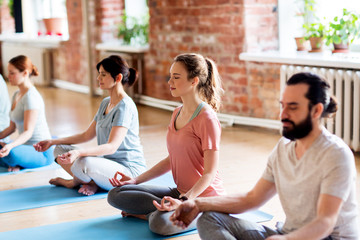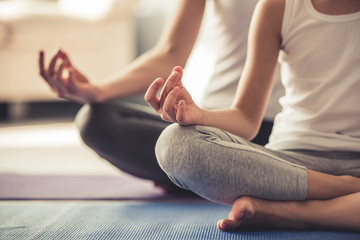Discover the power of visualization: enhancing your meditation practice smartfityoga. Learn techniques for mindfulness and emotional growth with SmartFitYoga’s approach to the power of visualization.
Table of Contents
ToggleIntroduction
Meditation is an ancient practice that has been embraced for its numerous benefits in promoting mental, emotional, and physical well-being. In recent years, there has been a growing interest in using modern techniques to enhance traditional meditation practices, one of which is visualization. The power of visualization has been shown to deepen mindfulness, enhance relaxation, and help individuals achieve greater emotional regulation. In this blog post, we will explore how incorporating visualization into your meditation practice can help you improve your mental clarity, reduce anxiety, and foster a deeper sense of inner peace with SmartFitYoga.
Understanding the Basics of Visualization
Visualization is a mental technique that involves creating vivid and sensory-rich mental images, often with the goal of achieving a particular outcome or state of being. It’s commonly used by athletes, performers, and individuals looking to achieve personal growth. But what makes visualization so effective in meditation? The answer lies in the brain’s capacity to activate neural pathways that mimic real-life experiences. When you visualize a peaceful setting or positive emotions, the same regions of your brain that would be activated if you were actually experiencing those things light up. This phenomenon allows you to experience the benefits of relaxation and calm, even in moments of stress or tension.
When incorporated into meditation, visualization becomes an essential tool that helps focus your mind. As your thoughts tend to wander during meditation, visualizing a calm and peaceful scene can redirect your attention, guiding you back into the present moment. It helps you establish mindfulness by anchoring your awareness to a vivid image, making the process of stilling your mind more engaging and effective.
The Neuroscience Behind Visualization
Research has shown that visualization doesn’t just help us relax—it actively rewires our brain. The same neural circuits that are engaged when you physically perform a task are also activated during mental imagery. For example, a study on athletes showed that imagining yourself executing a sport skill activates similar neural patterns as physically performing the skill itself. This is why visualization can be so powerful—it strengthens mental and emotional resilience by training the brain to focus and react in certain ways.
When you combine this with meditation, you create a synergy that enhances your ability to focus. During your SmartFitYoga meditation practice, using visualization can increase your cognitive flexibility, allowing your mind to shift from distractions to stillness effortlessly. The more you practice, the more familiar these neural pathways become, leading to a quicker return to peace and a higher level of mindfulness.
Enhancing Focus and Relaxation
Visualization is a powerful tool for enhancing focus and relaxation. In the fast-paced world we live in, it’s easy for our minds to become cluttered with distracting thoughts. However, by practicing visualization, you can direct your attention and allow yourself to focus on one specific image. This has the immediate effect of quieting the mind, reducing mental noise, and helping you access a more peaceful, calm state of being.
For example, imagine yourself in a serene natural landscape—a quiet beach, a lush forest, or a mountain peak. As you meditate, allow yourself to immerse fully in the imagery. Visualize the colors, sounds, and textures. Engage all your senses. Notice the sound of the ocean waves, feel the warmth of the sun, and smell the fresh air. Doing so helps you center your awareness, shifting your focus from the distractions around you to the tranquility of your visualized environment.
This focused meditation practice helps clear the mental clutter and creates a powerful sense of relaxation. By using visualization in this way, you allow your body to relax, your breath to deepen, and your stress levels to diminish. Over time, these focused meditation sessions can reduce overall stress and anxiety, providing lasting emotional and physical benefits.

The Emotional Benefits of Visualization
the power of visualization: enhancing your meditation practice smartfityoga doesn’t just calm the mind—it can also have profound emotional benefits. When you visualize positive experiences or scenarios, your brain responds by releasing neurotransmitters that promote happiness and emotional well-being. Studies have shown that regularly engaging in positive visualization practices can enhance emotional regulation, reduce negative emotions, and increase feelings of happiness and contentment.
In the context of meditation, this means that visualization can help individuals cultivate greater emotional resilience. By repeatedly visualizing positive scenarios—such as feeling confident in a challenging situation or imagining a harmonious relationship with others—you train your mind to respond to stress with composure and calm.
For example, imagine a situation where you are feeling anxious or overwhelmed. Through your visualization practice, you might picture yourself handling that situation with grace, staying calm and collected in the face of challenge. Doing this regularly helps build emotional strength and reprograms your automatic responses to stress, creating an overall sense of balance.
Visualization for Manifestation and Goal Setting
One of the most powerful aspects of visualization is its ability to manifest goals. When you visualize your desired outcomes in vivid detail, you signal to your subconscious mind that these goals are achievable. Visualization can create a strong mental connection between your present self and the future version of you that has accomplished those goals. This helps you align your thoughts, behaviors, and actions with the outcome you desire, increasing the likelihood of success.
For those practicing meditation with SmartFitYoga, using visualization as part of goal-setting can make your meditation practice even more purposeful. Whether your goals are related to physical health, career achievements, or personal development, visualization can help clarify your intentions and keep you motivated. By picturing yourself achieving those goals in a peaceful, meditative state, you reinforce the belief that success is attainable, helping you stay focused and driven in the real world.
Building Resilience with Visualization
Visualization is an effective tool for building resilience, particularly in the face of challenges or adversity. The mental imagery you create during meditation can help you cultivate a sense of inner strength and emotional fortitude. By repeatedly visualizing yourself overcoming obstacles, handling difficult emotions, and emerging stronger from setbacks, you train your mind to approach future challenges with confidence.
Resilience is the ability to bounce back from adversity, and visualization can play a key role in developing this trait. During SmartFitYoga sessions, take time to envision yourself navigating tough situations with composure. By seeing yourself succeed, you are better prepared for real-world challenges, and your subconscious mind becomes equipped with the tools to cope with stress in a healthier way.
Practical Visualization Techniques for Meditation
To effectively incorporate visualization into your meditation practice, it’s essential to understand how to use it. Here are some practical tips:
- Choose a Peaceful Scene: Start by imagining a peaceful, relaxing scene. This could be a beach, forest, mountain, or any place that evokes a sense of calm. Make the scene as vivid and sensory-rich as possible.
- Focus on Details: Engage all your senses. Imagine not just what you see, but also what you hear, feel, smell, and taste. The more details you add, the more real the scene will feel.
- Set an Intention: If you’re using visualization for a specific goal, focus on that goal during meditation. Visualize achieving it in as much detail as possible. Include the emotions you’ll feel once you achieve it.
- Allow the Scene to Evolve: As you practice, allow your visualizations to evolve. Sometimes the images will shift on their own as your mind becomes more relaxed and open to new ideas.
- Repeat Regularly: Visualization, like any meditation practice, requires consistency. Set aside regular time to practice and let the images you visualize become clearer and more vivid over time.

Visualization for Physical Health
The benefits of visualization aren’t confined to emotional and mental health—they can also improve physical well-being. Visualization can promote healing by stimulating the body’s natural relaxation response and reducing stress-related ailments. Research suggests that visualization can help lower blood pressure, improve immune function, and reduce chronic pain.
During your meditation practice, try visualizing your body healing and becoming stronger. This could involve imagining your body’s cells regenerating, muscles becoming more flexible, or your energy levels increasing. Such visualizations help reinforce positive health outcomes, supporting the body’s ability to heal itself. By combining relaxation techniques with vivid mental imagery, you send a powerful message to your body to activate its healing processes.
Visualization for Stress Relief
the power of visualization: enhancing your meditation practice smartfityoga, Stress is one of the most common causes of health problems today, and visualization can be a highly effective technique for managing and relieving stress. By using visualization, you can mentally escape from stressful situations, bringing your body into a state of deep relaxation. As you engage in a meditation session with SmartFitYoga, visualize a calming, serene environment that helps ease your tension.
For example, imagine yourself floating on a calm lake or resting beneath the canopy of a quiet forest. Picture yourself inhaling deeply and exhaling all your worries, with each breath bringing more relaxation. The more you practice these types of visualizations, the better equipped you will be to handle stress in everyday life.
Cultivating a Mindful State with Visualization
Mindfulness is the practice of being fully present in the moment, without judgment. Visualization can be an effective tool in cultivating mindfulness, as it directs your attention to a specific mental image, allowing you to stay in the present. As you focus on your visualization during meditation, your mind becomes anchored in the moment, preventing distractions and promoting a sense of calm and clarity.
Visualization can be used to enhance mindfulness in a variety of ways. For instance, you might visualize your breath as a gentle wave moving in and out, or imagine each part of your body relaxing and releasing tension. These practices help ground you in the present, fostering a deeper sense of awareness and connection to your inner self.
Overcoming Mental Blocks with Visualization
At times, our meditation practice can be hindered by mental blocks—thoughts or emotions that prevent us from reaching a peaceful state. Visualization can help break through these blocks by redirecting our focus toward positive imagery. If you find yourself struggling with negative thoughts or self-doubt during meditation, visualize a positive outcome or achievement. This mental shift can create space for relaxation, healing, and personal growth.
The Role of Visualization in Achieving Inner Peace
Visualization is a powerful tool for achieving inner peace. By creating a calm mental environment and focusing on positive imagery, you can achieve a profound sense of tranquility. This practice encourages you to let go of anxiety and tension, paving the way for mental and emotional balance. When practiced regularly, visualization can help you maintain a sense of peace in your everyday life, no matter the circumstances.

Conclusion
Incorporating the power of visualization: enhancing your meditation practice smartfityoga is a powerful way to enhance your overall well-being. From improving mental clarity and emotional regulation to fostering relaxation and resilience, the benefits are immense. At SmartFitYoga, we encourage you to explore visualization as a way to deepen your meditation practice and cultivate a greater sense of mindfulness. By integrating these techniques into your routine, you can transform your meditation practice into a tool for lasting peace, growth, and personal transformation.





